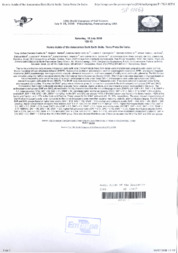Humic Acids of the Amazonian Dark Earth Soils: Terra Preta De Índio.
Humic Acids of the Amazonian Dark Earth Soils: Terra Preta De Índio.
Author(s): CUNHA, T. J. F.; MADARI, B. E.; MARTIN NETO, L.; CANELLAS, L. P.; SIMOES, M. L.; SILVA, W. T. L. da; MILORI, D. M. B. P.; RIBEIRO, L. P.; ANJOS, L. H. C.; SANTOS, G. de A.
Summary: The humic acid fraction (HA) of some Amazonian dark earth soils (Terra Preta de Índio) from Brazil were characterized using ultraviolet-visible (UV-Vis), Fourier transform diffuse reflectance infrared (DRIFT), fluorescence excitation and emission, electron paramagnetic resonance (EPR), and nuclear magnetic resonance (NMR) spectroscopy, thermogravimetric analysis, elemental composition, and measurement of acidity (total, carboxylic, phenolic). The HA fraction was extracted using the method recommended by the International Humic Substances Society (IHSS). The HA samples were separated in 3 groups based on the corresponding land use of the area of its origin: anthropogenic soils under forest (SAF), anthropogenic soils under agricultural use (SAC), non-anthropogenic soils under forest (SNAF). The SNAF soils were representative of Amazonian soils. They were collected in adjacent areas to the anthropogenic soil profiles. This way the SNAF group was a reference group for comparison purposes to the anthropogenic soil groups (SAF and SAC). Comparative (test t) and multivariate statistical analyses (factor analysis, cluster analysis, and discriminant analysis) were applied in the study. The anthropogenic soil groups (SAF and SAC) showed better fertility characteristics than the non-anthropogenic soils (SNAF) (pH: SAF = 5.1, SAC = 5.4, SNAF = 4.4; base saturation [V%]: SAF =59, SAC = 51, SNAF = 18; calculated cation exchange capacity [CEC]: SAF = 17.5, SAC = 17.2, SNAF = 9.5 cmolc/kg; available P: SAF = 116, SAC = 291, SNAF = 5 mg/kg). In the SAF and SAC soil groups ~44% of the total carbon was found in the humic fraction, ~32% in the humic acid fraction, and ~13% in the fulvic acid fraction. These values for the SNAF soils were 49, 19, 16%, respectively. The most relevant characteristics of the HA of anthropogenic soils, when compared to the non-anthropogenic ones were their superior reactivity, stability, and humification degree. The HA of the SAF and SAC groups featured higher total acidity (SAF = 612, SAC = 712, SNAF = 575 cmolkg) and carboxylic acidity (SAF = 435, SAC = 454, SNAF = 320 cmol/kg), higher concentration of organic free radicals (SAF = 4.07, SAC = 6.59, SNAF = 2.11 spin g-1 1017), higher thermogravimetric index (ITG) (SAF = 3.0, SAC = 3.3, SNAF = 2.3), lower E4/E6 ratio (SAF = 4.2, SAC = 4.2, SNAF = 6.0), higher aromaticity index (IADRIFT: SAF = 0.87, SAC = 0.85, SNAF = 0.77; NMR(%): SAF = 36, SAC = 39, SNAF = 25), higher hidrophobicity index (SAF = 0.37, SAC = 0.48, SNAF = 0.35), higher humification degree (A4/A1: SAF = 2.574, SAC = 3.313, SNAF = 1.713; I485/I400: SAF = 2.004, SAC = 2.161, SNAF = 1.510), and were more recalcitrant (recalcitrant C/labile C: SAF = 2.0, SAC = 2.0, SNAF = 1.0) than the HA of the SNAF group. Data also showed that there was difference between the HA of the SAF and SAC soil groups.
Publication year: 2006
Types of publication: Abstract in annals or event proceedings
Unit: Embrapa Semi-arid Region
Keywords: Soil, Solo, Terra Preta de Indio
Observation
Some of Embrapa's publications are published as ePub files. To read them, use or download one of the following free software options to your computer or mobile device. Android: Google Play Books; IOS: iBooks; Windows and Linux: Calibre.
Access other publications
Access the Agricultural Research Database (BDPA) to consult Embrapa's full library collection and records.
Visit Embrapa Bookstore to purchase books and other publications sold by Embrapa.

